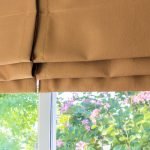Window treatments are essential for improving both the aesthetics and functionality of your living space. Among the many options available, Roman blinds and Roman shades are popular choices due to their timeless appeal and versatility. However, these two terms are often used interchangeably, leaving many people wondering how they differ. In this blog, we’ll dive into the distinctions between Roman blinds and Roman shades, review their unique qualities, assess their advantages and drawbacks, and pick the choice that suits your preferences.
What Are Roman Blinds?
Roman blinds are fabric-based window treatments that fold neatly into horizontal pleats when raised. When fully extended, they lie flat, creating a sleek and modern appearance.
Characteristics of Roman Blinds:
- Mechanism: Operated using cords or chains that lift the fabric into folds.
- Style Options: Available in a variety of fabrics, patterns, and textures to suit any décor.
- Light Filtering: The level of light control depends on the fabric’s thickness and lining.
- Fitting: Commonly mounted inside the window frame for a tailored look.
Benefits of Roman Blinds:
- Offers a clean, structured look that complements contemporary interiors.
- Customisable with a range of fabrics, including options for total blackout.
- Simple to maintain through routine vacuuming or spot cleaning.
Drawbacks of Roman Blinds:
- Provides less insulation compared to some other window treatments.
- Extended sunlight exposure can lead to fabric fading over time.
What Are Roman Shades?
Roman shades, like Roman blinds, are fabric-based window treatments. However, their construction gives them a softer, more relaxed appearance when lowered, as the fabric forms smooth, flowing folds.
Features of Roman Shades:
- Operation: Similar to blinds, they are raised and lowered using cords, chains, or motorised systems.
- Design Style: Known for their casual elegance, they work well in spaces seeking a cosy feel.
- Light and Privacy Control: Available in various fabrics to filter light or provide blackout effects.
- Installation: Can be mounted inside or outside the window frame, depending on the desired look.
Advantages of Roman Shades:
- Creates a welcoming, comfortable atmosphere with their soft folds.
- Pairs beautifully with curtains for added depth and texture.
- Roman blinds are a fabric-based window treatment designed to add elegance and functionality to interior spaces.
Limitations of Roman Shades:
- Requires more frequent cleaning to maintain their fresh appearance.
- May not suit interiors with highly modern or minimalist designs.
Differences Between Roman Blinds and Roman Shades
While Roman blinds and Roman shades share similarities in their fabric construction and functionality, their distinctions lie in the details of their design and aesthetic.
| Feature | Roman Blinds | Roman Shades |
| Appearance | Structured, with defined horizontal pleats | Soft, flowing folds |
| Design Style | Clean and modern | Warm and inviting |
| Light Control | Moderate to high, based on fabric | Varies depending on fabric and lining |
| Fabric Options | Wide range, including textured fabrics | Equally versatile, often with softer finishes |
| Maintenance | Relatively low maintenance | Needs more attention to retain shape |
| Best Use | Ideal for minimalist, contemporary spaces | Suited for traditional or eclectic interiors |
Choosing Between Roman Blinds and Roman Shades
The choice between Roman blinds and shades largely relies on your requirements, tastes, and your home’s décor. Here are some tips to guide you:
- Design Preferences: Roman blinds are perfect if you prefer a sleek, structured look, while Roman shades work well if you want a softer, more casual aesthetic.
- Light and Privacy: Consider the function of the room. For bedrooms or home offices, Roman blinds with blackout fabric may be ideal. In living spaces, shades that diffuse light create a warm, ambient feel.
- Maintenance: If low-maintenance window coverings are a priority, blinds are a better choice. Shades, while beautiful, may require more upkeep to retain their relaxed folds.
- Budget: Both options are customisable, but factors like fabric choice and operating systems can influence the price.
Why Choose Roman Blinds?
Roman blinds work best for:
- Spaces with a minimalist or modern design aesthetic.
- Rooms that require precise light control, such as bedrooms or home offices.
- Homes looking for a tailored, no-fuss window treatment.
Why Choose Roman Shades?
Roman shades are a great choice for:
- Living rooms, dining areas, or bedrooms where a cosy, inviting feel is desired.
- Interiors that use layered window treatments, such as curtains paired with shades.
- Spaces featuring a traditional or eclectic design style.
Customising Your Roman Blinds and Shades
One of the greatest advantages of Roman blinds and shades is their adaptability. Both can be customised to meet specific needs and preferences, such as:
- Fabric Choices: Whether you want sheer, light-filtering, or blackout materials, the options are nearly endless.
- Operation Systems: Choose between manual cords, chains, or motorised systems for added convenience.
- Design Details: Personalise with unique patterns, textures, or trims to complement your space.
Conclusion
Roman blinds and Roman shades each bring unique qualities to a room, making them versatile and stylish options for any window. Roman blinds stand out with their structured elegance, while Roman shades offer a softer, more relaxed charm.
By understanding their differences, you can confidently select the right option to enhance your space. Both are timeless choices that can transform your home while offering practicality and beauty.



